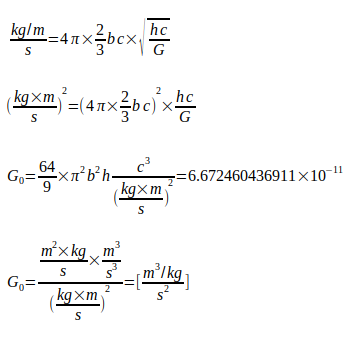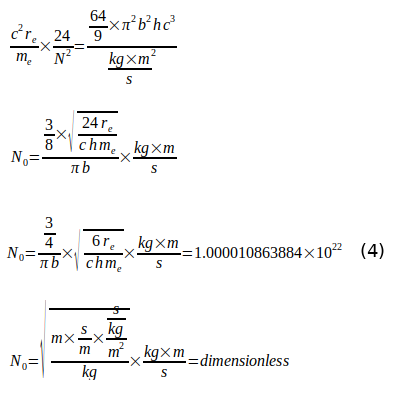Calculation of the gravitational constant G
The Law of Gravity states that all masses attract each other, that this force is proportional to the product of the masses, and indirectly proportional to the square of the distance between the masses. The gravitational constant makes an equation out of this relationship; it is one of the important universal constants of nature. In order to determine the constant, which was also named after Newton, exclusively mechanical methods were used in the past, which are subject to many disturbance variables, which is why G has hitherto been regarded as a constant with great inaccuracy.
By comparison, the uncertainty of a calculation is only due to the accuracy of the natural constants used. In the past, there were several fruitless attempts to compute G [1]. In the following, the author shows on the basis of the theory created in [2], [3]. Fundamentals a new possibility for the mathematical determination of the gravitational constant.
Calculations bring a reduction of the uncertainty of G by several orders of magnitude comes within reach. First of all, the determination by means of two opposing electrons at a distance r appears obvious. Analogous to Coulomb's law, in which charges with different signs attract each other, gravitation can be understood as an attraction of opposite poles, whereby Coulomb force Fc and gravitational force Fq differ greatly in magnitude:



The quotient Fc ∕ Fg is also called Eddington's number and even for Feynman the balance of forces between two interacting electrons had great significance. The quotient Fc ∕ Fg can be replaced by the term N2 ∕ 24, wherein N is referred to as a large number [2]. First of all, it is assumed that the  , recognized by the International Codata
, recognized by the International Codata
Committee in 1986, [4].


The result indicates that the Large Number N is a large number of about 1 X 1022. In 1986, data such as G= 6.672605 X 10-11 was typical, with the N = 1 X 1022 large number being assumed without further explanation [3]. The relationship between mass and natural constants is defined by the following relationship, Planck mass corresponding to Mo without π ∕ 2 Planck s intention of 1900. Z0 is the characteristic impedance of the vacuum [3].

These Eqs. connects to other constants of nature, and its extension offers the possibility of determining G0 as the basis for baseline data to determine the large number N0. In the following, the letter b is used for the fine structure constant α.
 (2)
(2)
The index 0 at G0 refers to the value for further calculations. After transformation of Eq. (1), one obtains

And by substitution of  , the absolute minimum variant of an equation for calculating G arises from this:
, the absolute minimum variant of an equation for calculating G arises from this:
 (3)
(3)
By equating equation (3) with equation (2), N can be obtained:

The index at N0 indicates the basis for further calculations. The rel. Uncertainty of N02 is due to the uncertainties of the constants involved with  ,
,  and
and  , the sum of which is
, the sum of which is  . Codata published the following binding values forduring the period from 1986 to 2014:
. Codata published the following binding values forduring the period from 1986 to 2014:
Table I
| Codata value | Uncertainty | Date |
|---|---|---|
 |
 |
1986 |
 |
 |
1998 |
 |
 |
2002 |
 |
 |
2006 |
 |
 |
2010 |
 |
 |
2014 |
The data show that G reached a maximum in 2006, which flattened again in the following years. The idea was born to relate this decreasing trend to the electron mass m_e, which, according to the transformed equation (3), results in G, so  . These values were referenced to the values G0 and N0 given in Eq. (2) and Eq. (4) for a precise evaluation. This results in the following deviations for the individual annual values:
. These values were referenced to the values G0 and N0 given in Eq. (2) and Eq. (4) for a precise evaluation. This results in the following deviations for the individual annual values:
Table II
 |
me-related deviations | |
|---|---|---|
 |
 |
Regard |
 |
 |
1986 |
 |
 |
1998 |
 |
 |
2002 |
 |
 |
2006 |
 |
 |
2010 |
 |
 |
2014 |
From these deviations related to the electron mass, it was deduced that the G increase indicated by Codata is also due to a me decrease given by Eq. (3). It was difficult to find the only cause in question. Between 1986 and 2014, the masses reported by Codata for me were negligibly reduced by  . So it could only be a cardinal error in determining G around 1986, which will be eliminated over the years. The first indications came from the influence of the co-movement of the proton in the hydrogen atom, which is much discussed in specialist literature.
. So it could only be a cardinal error in determining G around 1986, which will be eliminated over the years. The first indications came from the influence of the co-movement of the proton in the hydrogen atom, which is much discussed in specialist literature.
A finite heavy nucleus moves under the influence of the mass of the electron around the common center of gravity, resulting in the Rydberg constant Ry correction of the  form. At the same time the mass of the electron increases by its relativist. Orbital velocity
form. At the same time the mass of the electron increases by its relativist. Orbital velocity  , which shows the influence of other variables that are incomplete to be detected [5].
, which shows the influence of other variables that are incomplete to be detected [5].
The reduction of the Rydberg constant from Ry to Ryr also applies to the mass of the electron, as well as  . To determine the effective Rydberg constant Ryr, the hydrogen transition frequency mentioned by Codata in [6] is used:
. To determine the effective Rydberg constant Ryr, the hydrogen transition frequency mentioned by Codata in [6] is used:  (71). This results in the real effective Rydberg constant Ryr :
(71). This results in the real effective Rydberg constant Ryr :



The Rydberg constant Ry is considered to be the most accurate natural constant of all. The dimensionless quotient Q between it and the real effective Rydberg constant is the linchpin of the calculation
 (5)
(5)
The difference  corresponds to the me - related deviation shown in Table II. The comparison shows that the quotient can be used to overcome the problems mentioned in reproducing correct ratios for the H atom and also in determining G according to equation (3). On this basis, the gravitational constant can be calculated using equations (3), (4), (5).
corresponds to the me - related deviation shown in Table II. The comparison shows that the quotient can be used to overcome the problems mentioned in reproducing correct ratios for the H atom and also in determining G according to equation (3). On this basis, the gravitational constant can be calculated using equations (3), (4), (5).




 (6)
(6)
Now it is investigated which deviations have reliable data for G from the literature compared to the calculated value Gneu. To this end, in Table III only credible values are used for comparison, even if they are sometimes several years ago:
Table III
| Nominal value | Uncertainty | Ancestry | Year | Source |
|---|---|---|---|---|
 |
 |
G World | 1997 | [7] |
 |
 |
Uni Washington | 2000 | [7], [4] |
 |
 |
UCI-14 Input | 2014 | [6] |
 |
 |
Codata values | 2014 | [6] |
As the following Table IV shows, all deviations of these values from the calculated value  are within the uncertainty stated by the authors. The ratio of calculated deviation to uncertainty is less than one standard deviation.
are within the uncertainty stated by the authors. The ratio of calculated deviation to uncertainty is less than one standard deviation.
Table IV
| Quotient | Deviation | Abw./Uncertainty |
|---|---|---|
 |
 |
0.047 |
 |
 |
0.337 |
 |
 |
0.797 |
 |
 |
0.529 |
A comparison of the results of the state-of-the-art data according to [7], Table 7.5 with Gneu, shows that all tolerances specified therein are observed. It is different with regard to G given by Codata in [6] Table XV, where of the 14 references only the following 5 have the error tolerances assigned to them:
| Bagley and Luther (1997) LANL-97 |  |
| Gundlach and Merkowitz (2000, 2002) |  |
| Kleinvoß, Kleinvoß et al. (2002) |  |
| Schlamminger et al. (2006) UZur-06 |  |
| Newman et al. (2014) UCI-14 |  |
Table XV shows that values given by Codata to G are partly subject to large variations. This becomes clear when using the mean of the 14 contained values with  instead of Gneu, where only 4 out of 14 values are in the specified tolerance range.
instead of Gneu, where only 4 out of 14 values are in the specified tolerance range.
For the practical calculation of G, it makes sense to combine the results given in equation (4) and equation (5) into a constant K.

 (7)
(7)
From the abs. Minimal variant Eq. (3) allows further equations to be deduced by replacing the electron radius re once by the Relationship  and the other by the relation
and the other by the relation  :
:



The uncertainty in the calculation of G is mainly determined by N02 according to equation (4) or the constant  according to equation (7). In addition, the uncertainty of the electron mass
according to equation (7). In addition, the uncertainty of the electron mass  is given in equation (3). The inaccuracy of the constants still involved can be neglected. (
is given in equation (3). The inaccuracy of the constants still involved can be neglected. ( ,
,  ,
,  ). The uncertainty of the electron mass me thus determines the total error of the G calculation.
). The uncertainty of the electron mass me thus determines the total error of the G calculation.
The actual cause of the inaccuracy of me is the underlying Avogadro constant with  , which limits a further increase in the accuracy of G. In principle, the accuracy of G is limited to 3 times the NA uncertainty. Due to SI efforts, approximation to
, which limits a further increase in the accuracy of G. In principle, the accuracy of G is limited to 3 times the NA uncertainty. Due to SI efforts, approximation to  is planned [8], which indicates future accuracy limits of.
is planned [8], which indicates future accuracy limits of.
THE G-FIELD IS ENERGY! Consequently, there is no "empty" space. EVEN THE ELECTRON DELIVERS HIS CONTRIBUTION ..... (M. Geilhaupt)
The calculations are based on the following constants:








Literature
1. E. Suckert: Über Natur des Elektrons und Ursache der Gravitation, 2013
2. Prof. Dr. Manfred Geilhaupt: Fundamental Unit Momentum, 1986
3. Prof. Dr. Manfred Geilhaupt: Basic Units of Physics, 1984
4. Prof. Dr. Wolschin: Schwierige Bestimmung einer Naturkonstante, 2001
5. Samuel Miesch: Atomare Spektren - Bohrsches Atom- Modell, 2003
6. CODATA: Recommended Values of the Fundamental Physical Constants, 2014
7. Ulf Kleinevoß: Bestimmung der Newtonschen Gravitationskonstante,2002
8. David Newell: The CODATA 2017 values for the revision of the SI, 2018
Dipl.-Ing. (FH) Kurt Vogel
Email: kurt.vogel@gmx.de
Date: 30.04.2019
